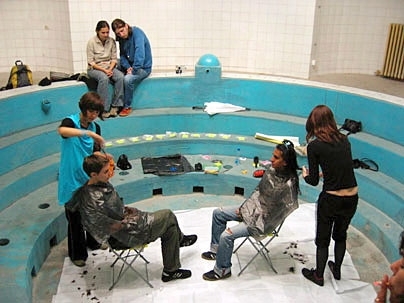Sarajevo native and architecture graduate student Azra Aksamija was among an international group of 40-100 artists and architects who, in summer 2006, traveled en masse along the so-called Highway of Brotherhood and Unity-a road made in Socialist Yugoslavia to connect the major cities of its republic. The trip, called the Lost Highway Expedition (LHE), was designed so cultural practitioners could experience the terrain of the Balkans and the region's heightened political space.
Thursday and Friday (Oct. 26, 2-5 p.m. and Oct. 27, 3-6 p.m.), Aksamija, Center for Advanced Visual Studies Curatorial Associate Meg Rotzel and other Lost Highway travelers will lead a series of programs at the CAVS in Room N52-390. The panelists will describe their experiences, share the LHE archive and discuss how the free-form group project was designed.
One of the stops on the route was Aksamija's own Sarajevo, the capital of Bosnia and Herzegovina, where she lived until she was 14. Prior to the start of the LHE, Aksamija returned to Sarajevo to work with local filmmakers, philosophers, historians, artists, curators and activists in preparation for the project's two-day stop in that city. Although these local contributors all knew each other, LHE gave them their first opportunity to collaborate on a project.
Video, photographs and other documentation from the journey are on view in the gallery at the Center for Advanced Visual Studies through Oct. 30.
Aksamija, a graduate student in architecture and in the Aga Khan Program for Islamic Architecture, discussed her Lost Highway experiences recently.
Q: What activity did you run during the trip?
A: I initiated and organized a temporary intervention of haircutting in an abandoned bathhouse in Belgrade. The literal translation of the title of the event, "Who Cuts Yours," comes from a phrase in Serbo-Croatian which not only refers to a haircut, but also means who cares about you. It was designed to build trust among LHE participants.
The project started as a hairdressing salon, but typical of LHE projects, it had its own dynamic. It was a spontaneous performance that developed into a community bonding experience.
We now have 35 bags of hair samples at the CAVS, which are the collective property of LHE, and we are discussing how it might become the basis of an art project. For example, we might scan them to have a DNA record of LHE participants.
Q: What were some of the other events along the "Lost Highway"?
A: We held presentations and forums by local and international experts on urban transitions from socialism to capitalism and workshops and collaborations between travelers and hosts. We staged exhibitions, radio shows, picnics and other events with collaborating cultural organizations and artist groups in our host cities.
For example, in Sarajevo local LHE participants and architects were asked to investigate and identify those remaining public spaces in Sarajevo that could be animated by independent culture.
We developed themes for "city-tours" to generate discussion about [these] public spaces and the role of culture and cultural institutions in the future. The topics included "Deconstruction of Monuments," "Continuation of War in Time of Peace: Spatial Mediation of Nationalism," "Need for Radical Space" and "Organized Chaos in Politics and Space."
The local experts who led the city-tours were asked to temporarily "occupy" these spaces with their guests in an improvised way. This meant that some of these walking lectures were held on bridges and in parks, bars, restaurants, private gardens and libraries. The advantage of such temporary and guerilla-like occupation of public space was that we didn't need any organization or permits. Everything was scheduled online.
Depending on the tour, visiting LHE participants were asked to make short (10-15 minute) presentations on such projects to exchange experiences with local institutions about possibilities of alternative use of public space.
Q: What were your personal achievements in the LHE?
A: I gained an incredible insight in the problems of the region, which is the sphere of my future dissertation. In the course of project development, I not only read, but also learned from my colleagues and established professional friendships. During the expedition, I further examined the contemporary sacral architecture in the Balkans, which is relevant to the research I am doing for my MIT dissertation.
Q: How will the LHE symposium benefit the MIT community?
A: The symposium will reflect on the exchange of information, knowledge or skills we experienced during the expedition. Cross-disciplinary work at MIT could benefit from the ideas and methods we used during the expedition. Our arrangements between artists and academics redefined the notion of departmental and disciplinary boundaries as flexible, moving, ephemeral and negotiating space.
A version of this article appeared in MIT Tech Talk on October 25, 2006 (download PDF).






